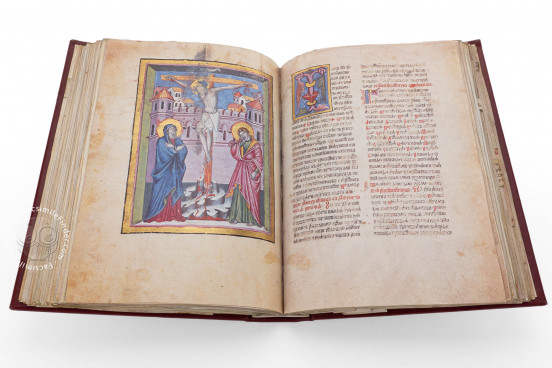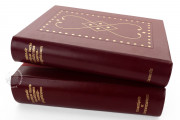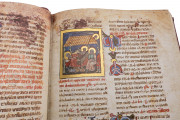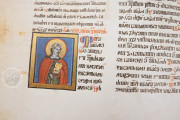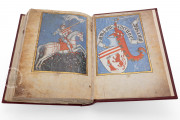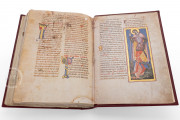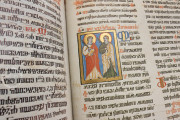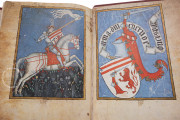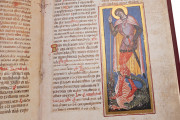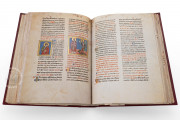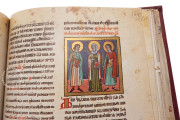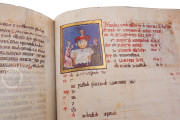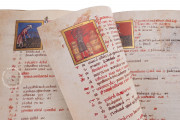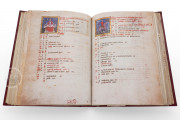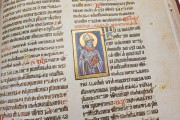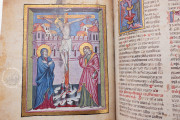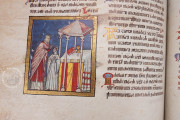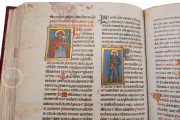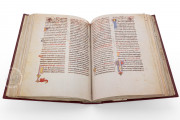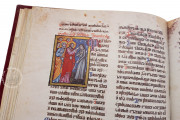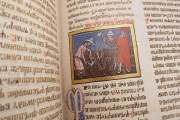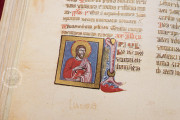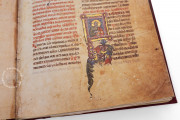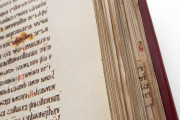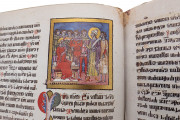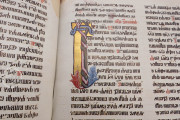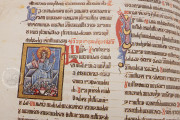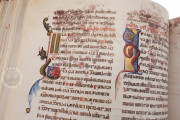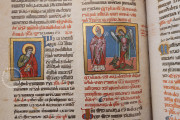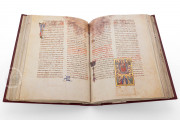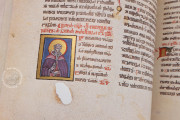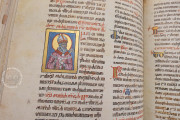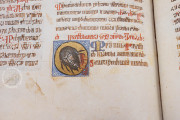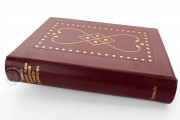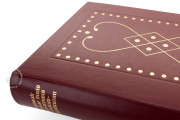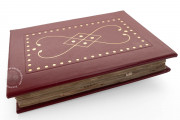The Hrvoje Missal, named for its patron, is a Christian liturgical manuscript created around 1403-1404 in Split for the reigning duke of the city. Written in the Glagolitic script of Croatia by the scribe Butko, the manuscript comprises the texts, both intoned and sung, of the liturgy of the Mass, the Christian rite focused on the sacrament of the Eucharist, the consecration and consumption of bread and wine. It is the most richly illuminated missal in Galgolitic script to survive from the Middle Ages, with ninety-two miniatures—including an equestrian portrait of the patron (fol. 242v)—and four historiated initials.
Hrvoje Vukčić Hrvatinić (1350-1416), Duke of Split and governor of Croatia, Dalmatia, and Bosnia for Ladislao (1377-1414), King of Naples, commissioned the book. The duke is pictured in a full-page equestrian portrait facing a lavish depiction of his coat of arms (fols. 242v-243r).
Painting Style at a Crossroads
Fifteenth-century painting in the Balkans naturally reflected the dominant styles and conventions of the major artist centers of Western Europe and Byzantium. In the Hrvoje Missal, one sees, for example, a European-style Resurrection, with Christ striding confidently out of his sarcophagus (fol. 98v), among miniatures that demonstrate a familiarity with Byzantine stylistic conventions.
Surprising Narrative Scenes
An unusual feature of the Hrveje Missal is the inclusion of Old Testament narrative scenes. The miniature of Daniel in the Lions' Den shows the Hebrew prophet Daniel and the lions in a cave; golden rays signify that the prophet has been miraculously saved, and the Persian king points to the scene and speaks to the courtiers who will soon take Daniel's place in the lions' den (fol. 61v).
Picturing Miracles
Another surprising inclusion is scenes from Christ's ministry: the Wedding Feast at Cana, Christ and the Samaritan Women, the Healing of the Man Born Blind, and the Raising of the Son of Nain (fols. 18r, 47v, 54v, and 56r). These subjects are inspired not by the feast day, as is usual, but by the substance of the Gospel readings.
Twin Emphases: Franciscans and Winemaking
The liturgy of the Balkan Peninsula in this period was Franciscan, and we find masses for and portraits of Franciscan saints in the missal. These include Saints Anthony of Padua (1195-1231), Clare of Assisi (1194-1253), Louis of Toulouse (1274-1297), and Francis of Assisi (1182-1226) (fols. 162v, 174r, 176r, and 183v).
The manuscript's liturgical calendar appears in the middle of the book (fols. 142-147). Each month occupies a page and is illustrated by an activity—usually agricultural—associated with that month. In the Hrveje Missal, four months feature labors pertaining to winemaking—February, August, September, and October (fols. 142v, 145v, 146r, and 146v)—appropriate for a manuscript produced in a region where wine cultivation was (and is) important.
Colorful Painted Initials
The scribe, Butko, wrote the text in Glagolitic script in two columns, the usual format for missals of the period. Hundreds of decorated initials display foliate and floral motifs in brilliant color. He wrote instructions for the illuminator in both Glagolitic and Latin letters, and it is uncertain what languages that artisan commanded.
A Croatian Treasure Now in Türkiye
The manuscript is in the collection of the Topkapı Sarayı in Istanbul, but we do not know how it came there. Its current binding dates from the nineteenth century.
We have 1 facsimile edition of the manuscript "Hrvoje Missal": Missale Hervoiae Ducis Spalatensis croatico-glagoliticum facsimile edition, published by Akademische Druck- u. Verlagsanstalt (ADEVA), 1973
Request Info / Price
